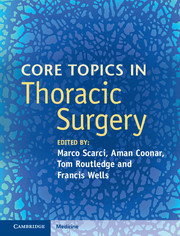Book contents
- Frontmatter
- Contents
- List of contributors
- Section I Diagnostic work-up of the thoracic surgery patient
- Section II Upper airway
- Section III Benign conditions of the lung
- Section IV Malignant conditions of the lung
- Section V Diseases of the pleura
- Section VI Diseases of the chest wall and diaphragm
- Section VII Disorders of the esophagus
- Section VIII Other topics
- 26 Thoracic trauma
- 27 Thoracic sympathectomy in the treatment of hyperhidrosis
- Index
- References
27 - Thoracic sympathectomy in the treatment of hyperhidrosis
from Section VIII - Other topics
Published online by Cambridge University Press: 05 September 2016
- Frontmatter
- Contents
- List of contributors
- Section I Diagnostic work-up of the thoracic surgery patient
- Section II Upper airway
- Section III Benign conditions of the lung
- Section IV Malignant conditions of the lung
- Section V Diseases of the pleura
- Section VI Diseases of the chest wall and diaphragm
- Section VII Disorders of the esophagus
- Section VIII Other topics
- 26 Thoracic trauma
- 27 Thoracic sympathectomy in the treatment of hyperhidrosis
- Index
- References
Summary
Epidemiology and etiology
Despite patients’ reluctance to seek out medical attention, hyperhidrosis is not as rare a disorder as would be perceived and has historic roots in the medical literature. The condition is divided into primary and secondary hyperhidrosis. Secondary hyperhidrosis is a generalized sweating typically affecting the entire body and is consequent to underlying metabolic, neoplastic, infectious or endocrine conditions. Some examples of these conditions include diabetes mellitus, hyperthyroidism, carcinoid syndrome, malignancies such as lymphoma, tuberculosis, systemic shock, heart failure, Parkinson's disease and spinal cord injuries. In contrast, primary (idiopathic) hyperhidrosis is typically focal and is defined as the production of sweat by eccrine glands that is beyond the body's physiological parameters for thermoregulation. Usually this is an exaggerated response to a physiological stress or emotional/psychological stimulus. Moreover, primary hyperhidrosis is subcategorized based on location (palmar, plantar, axillary or craniofacial). For the purposes of this chapter, the term ‘hyperhidrosis’ will be used to refer more specifically to primary hyperhidrosis.
The incidence of hyperhidrosis varies in the literature. An earlier Israeli study reported incidence rates of 0.6–1.0%. More recent evidence suggests that the prevalence of hyperhidrosis is higher, ranging from 2.8% in the United States to 4.6% in specific parts of China. An estimate suggests that the condition affects roughly 7.8 million individuals in the United States. The variability in epidemiologic data reflects two principles characteristic of hyperhidrosis. First, the definition of hyperhidrosis is unclear, largely leading to subjective reliance for diagnosis, as well as the potential for over- or under-reporting. Second, individuals suffering the condition often do not seek medical care, either due to social discomfort or to a lack of knowledge of possible treatment options.
Commonly, individuals are diagnosed early in adulthood, considering the role of pubertal heightening of the disorder. Gender distribution is equal, with the greatest prevalence existing among working-age adults. Moreover, a genetic predilection appears to exist, with 25–50% of cases demonstrating an autosomal dominant pattern of inheritance of variable penetrance. This familiar pattern of inheritance appears to be more strongly correlated with individuals presenting prior to the age of 20. Focally, the most common site for severe disease appears to be palmoplantar hyperhidrosis of the palms and soles. Other common sites for severe disease include the combination of the palms and axillae (15–20%), the axillae alone (5–10%) and craniofacial region (5%).
- Type
- Chapter
- Information
- Core Topics in Thoracic Surgery , pp. 267 - 274Publisher: Cambridge University PressPrint publication year: 2016



